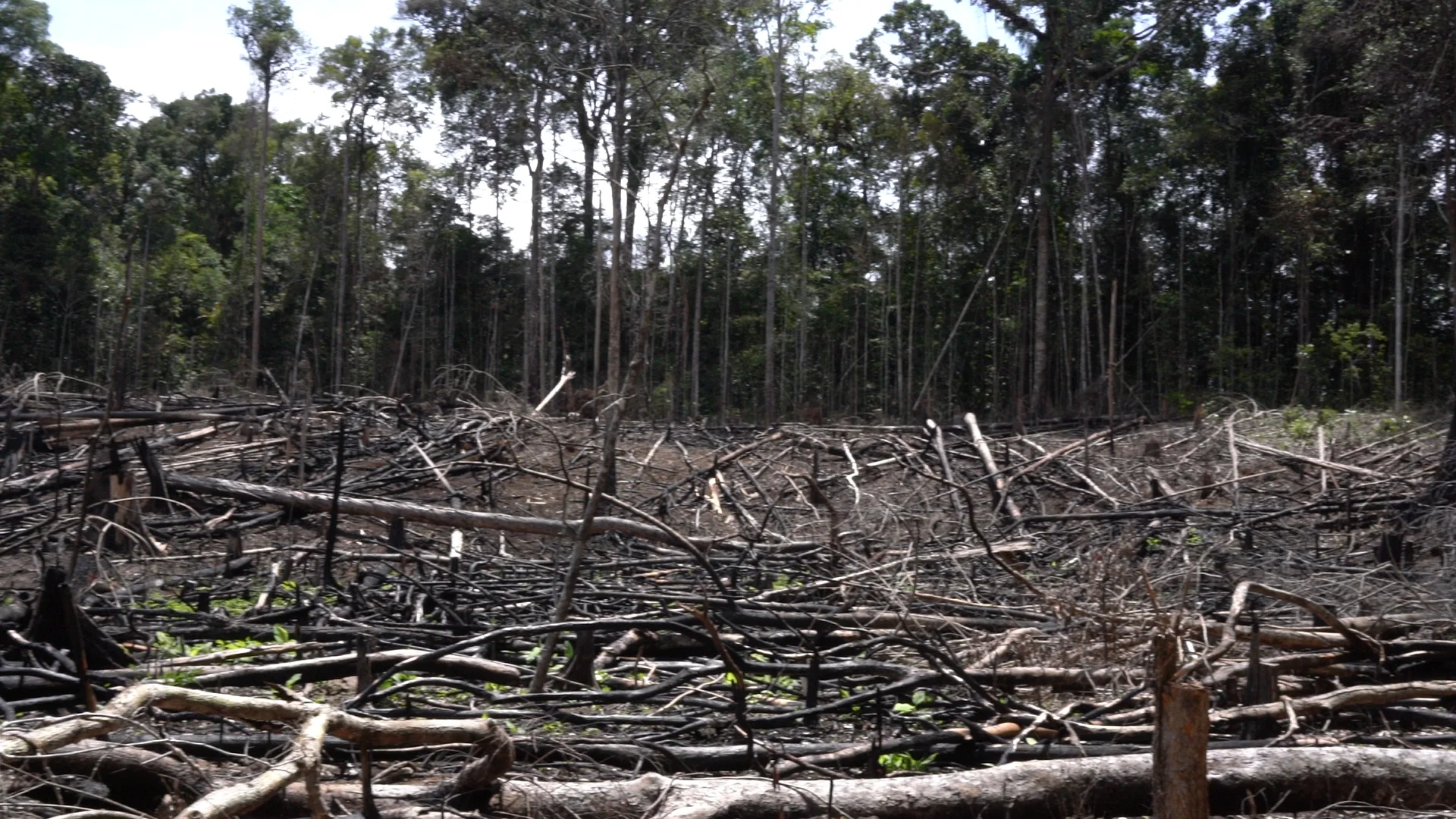New Hope For One of the World’s Rarest Birds
The female helmeted hornbill is the lesser known but just as beautiful and exotic as the male, with a slightly smaller and rounder casque and a striking light turquoise leathery neck.
She checks out a cavity on the side of a tree trunk protruding from the canopy of the nature reserve we work in.
She’s checking it to see if it’s suitable for a nest and later the male comes to inspect with her. The species is markedly picky when selecting an empty cavity for nesting, warranted because the female will be trapped inside it for the next 6 months raising her nearly born chick. This one, they approve.
Together, the life partners clean and prepare the cavity while some 40 meters below them hidden by the thick tree cover of the Bornean rainforest a human stalks their actions.
Rikardus, a member of Planet Indonesia’s Biodiversity team had just finished collecting data about the wildlife in the nature reserve for the day when he had heard their calls.
The bird’s song is loud and unmistakeable. It starts with a slow-paced OOOHH before it reaches a climax of manic cackling that reverberates throughout the forest. For a trained ear, like Rikardus’, it’s possible to determine which direction the echoing calls are coming from to track the birds, which is how he happened upon this pair.
The first active nest to be recorded in the province since 2010, it was a noteworthy find, the word spread internationally to major news organisations such as the BBC and the National Geographic who did an extensive series on the bird. Government officials made the 5km uphill hike to make sure the nest was there. The activities and the mere existence of the nest was documented heavily by a number of parties.
But while interest from outsiders peaked at various times throughout the months of February (when the nest was discovered) to September (when the chick finally left the nest), to look after the family of Helmeted Hornbills for the entire duration was a gruelling marathon that required constant and intense attention from our Biodiversity and Smart Patrol teams.
Sources tell us, this could be the first nest discovered for this in bird within Indonesian-Borneo for almost 9 years.
The trek to the nest starts with a 5-6-hour car ride from Pontianak, then motorbikes for an hour across rocky paths only locals or professional stunt drivers would know how to ride. After getting dropped off at a village just outside the nature reserve you hike uphill through the dense rainforest for three hours before arriving to the Planet Indonesia camp.
You’d want to fall asleep around 8PM because wakeup call is at 4AM. It’s important to reach the nest by 5AM, before the sun does. Then it’s 11 hours of observation and documentation by three of our team members stationed at different locations. That was done for 2 weeks of every month, a rotating roster shared by Planet Indonesia’s Biodiversity and Wildlife Protection Unit (WPUs) teams, void of any insect repellents or audible talking lest the male Helmeted Hornbill be frightened off.
The male has been known to abandon the nest if it senses too much danger which is a death sentence for the female and their chick since they rely on him to bring them food. Unsurprisingly, this is also when the birds are the most vulnerable to poachers.
They’re an extremely sensitive bird, the wariest of all the hornbills who usually stay high in the canopies. Their cautious nature means they’re extremely difficult to poach as they’ll sense threats from miles away. Their nesting practices however are so routine and anchors them to a single tree for months – it is the optimal time for hunters to shoot down the male and/or take the chick.
The primary market for the birds come from the wealthy in China where the casque sells for 5 times the price of elephant ivory. Naturally, wildlife poachers were quick to take note. In 2013, an estimated of 6,000 were killed in West Kalimantan alone, last year an estimated 400 per month.
To paint it like that, it seems like a pretty black and white scenario with a seemingly clear antagonist and victim; stop the poachers at any cost and save the birds - but conservation is never that simple.
In the nature reserves we work in the birds also faced a healthy threat from the Indigenous human populations.
There, it was customary to hunt the Helmeted Hornbill for its meat, its feathers and ivory.
A site where the trees have been burnt and chopped down in the nature reserve.
Building a working relationship with the villagers was central in ensuring the Helmeted Hornbill family stayed safe. The village actively hunted the birds before we partnered with them and while this mission was successful, there was a lot of weariness and distrust we had to mitigate. Many were worried we had ulterior motives and were out to rob them of their land and resources like so many had done and continue to try do now.
The villagers had lived in the area under their own laws and traditions for generations before the Federation of Indonesia began implementing theirs. The most impactful was the government’s declaration that their land would become a natural reserve in 1980.
Now, the Indigenous people have to learn to maneuverer through a web of complex social, economic and environmental issues, many no fault of their own. They previously lived off the land but now as a citizen of Indonesia, it is illegal for them to conduct any activities that alters the natural reserve.
On the flip side, the encroachment of capitalism leaves them no choice but to resort to unsustainable and dangerous jobs within industries such as illegal hunting or logging of endangered animal and tree species.
And with so much of the rainforest’s beings facing extinction, threatening the wellbeing of the ecosystems that the local communities rely on, the villagers must find a way to avoid impoverishment without dilapidating the rainforest they call home.
Our role has been to help the villagers develop alternative and sustainable livelihoods while improving management of their natural resources by establishing community-based Conservation Cooperatives (CCs). Through these CCs we offer business, education and health services and offer training sessions for necessary production skills - addressing the root causes of rural poverty linked with biodiversity loss. Through this process we collaborate with villages through agreements to protect the rainforest and the wildlife within it. A process you can read more about here.
It is in the interest of the villagers who rely on the rainforest for clean water, food and other resources that the Helmeted Hornbill continue on. They are the rainforest’s farmers, who spread the seeds of the Ficus fruit, an important food source for other wildlife.
They are also a culturally significant symbol for the Dayak people, representing dignity, peace, unity and leadership.
This is a highly telling journey that more and more front-line conservationists are being forced to undergo. We dedicated an awful lot of resources for the protection of a single chick but when the existence of a species necessary for the sustainability of massive ecosystems are shaved down to the wire, every life matters.
It’s also not just up to us to protect them. At the center of approach is collaborating with local communities. They are the ones who will decide whether or not to participate in the hunting of endangered species or cutting down of the trees, and we have to address the issues that force them into these environmentally unsustainable, financially unstable, socially unjust and simply backbreaking work.
If we don’t, the Helmeted Hornbill and all those lives in this biodiverse haven will disappear forever.
Follow us on our social media which you can find here and here to get timely updates on our activities and ongoing programs of which we have many. We work in a multi-faceted and levelled approach to ensure our successes is for the benefit of everyone involved and that it delivers long-term relief. To support our mission directly you can donate here.



